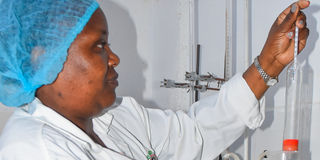Kenyan scientist develops kit for detecting antibiotics in raw milk

Dr Teresiah Ndung’u tests milk at Ol Kalou Dairy in Nyandarua County
What you need to know:
- Doctors have for decades lamented about antibiotic residues in milk, blaming them for causing antibiotic resistance in the human body.
- Antibiotic resistance leads to higher medical costs, prolonged hospital stays and increased mortality.
A Kenyan scientist has developed an advanced kit that instantly detects antibiotic residues in raw milk.
Doctors have for decades lamented about antibiotic residues in milk, blaming them for causing antibiotic resistance in the human body. Antibiotic resistance leads to higher medical costs, prolonged hospital stays and increased mortality.
Dr Teresiah Ndung’u, who developed the kit, is the first woman in Kenya to graduate with a PHD in Dairy Technology.
The development of the test kit is a culmination of three years of trial and error at Egerton University, Nakuru Campus.
“The kit works by mixing 3ml of raw milk with 0.5 grammes of powder made of five ingredients. It’s rapid, meaning the results are immediate. I believe the kit will help address challenges in milk production from the grassroots. We are working with Egerton University to make the kit available to dairy farmers’ cooperative societies and other handlers of milk through the value chain,” said Dr Ndung’u, who is also the Nyandarua County director for Livestock and Fisheries departments.
Antibiotic resistance is rising to dangerously high levels in all parts of the world, according to the World Health Organization.
“We run the risk of going back to the pre-antibiotic era where a simple infection would send you six feet under. The antibiotic residues in milk and other animal products expose us to suboptimal doses of the drugs. Continuous exposure renders bacteria in our bodies resistant to antibiotics. Should you get an infection from such bacteria, first-line antibiotics are rendered useless, necessitating higher level antibiotics that are more effective but more expensive and requiring expertise to administer,” explained Dr Geoffrey Kiriri, the Nyandarua County Pharmacist.
Dr Kiriri noted that substances used to make livestock and human drugs are the same and that what differs is the dosage. This means that the Amoxil used to manufacture animal medicines is similar to that used in making human drugs or the antibiotics — the only difference is content amount. In animals, these residues can be traced in meat or milk.
Dr Mwangi Njururi, researcher and director at Health Living Centre in Nyeri, said these antibiotic residues cause organ damage and opportunistic diseases that can’t be treated.
Prof Mary Omwamba of Egerton University, who supervised the research and development of the kit, described Dr Ndung’u as passionate about food safety. She said the latest milk test technology is efficient and effective.
“The kit is easy to use and rapid. Sensitive tests are needed in the dairy industry. We are proud of this achievement, it’s a milestone,” said Prof Omwamba.
She added that the university is working on modalities to make it accessible to dairy industry stakeholders.
Prof Patrick Muliro, who also supervised the research, said the kit is registered with relevant government agencies including the Kenya Industrial Property Institute, which is responsible for intellectual property rights.
Dr Ndung’u noted that the usage of the kit needs minimal training, adding that it enables milk buyers or collectors to conduct tests at collection points.
“The quality of milk should be established before it’s taken to the processor. You will find that milk from several farmers is normally put in the same container, making it impossible for buyers to establish which farmer brought contaminated milk. With this kit, the problem will be detected at the source.”
“The other mistake farmers make is failure to cool the milk within three hours after milking, compromising the quality,” said Dr Ndung’u. In Nyandarua County, she has trained veterinary officers and livestock development officers on milk testing.





